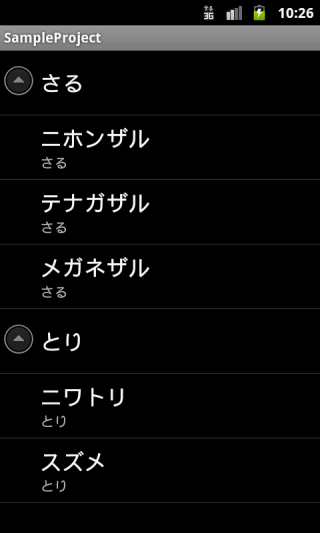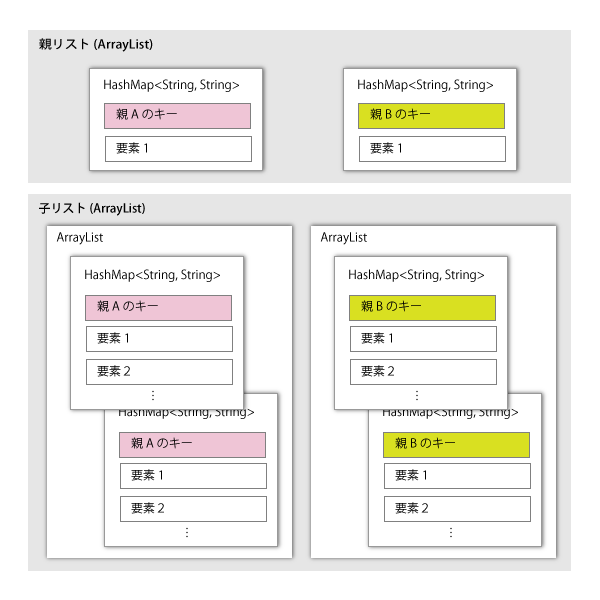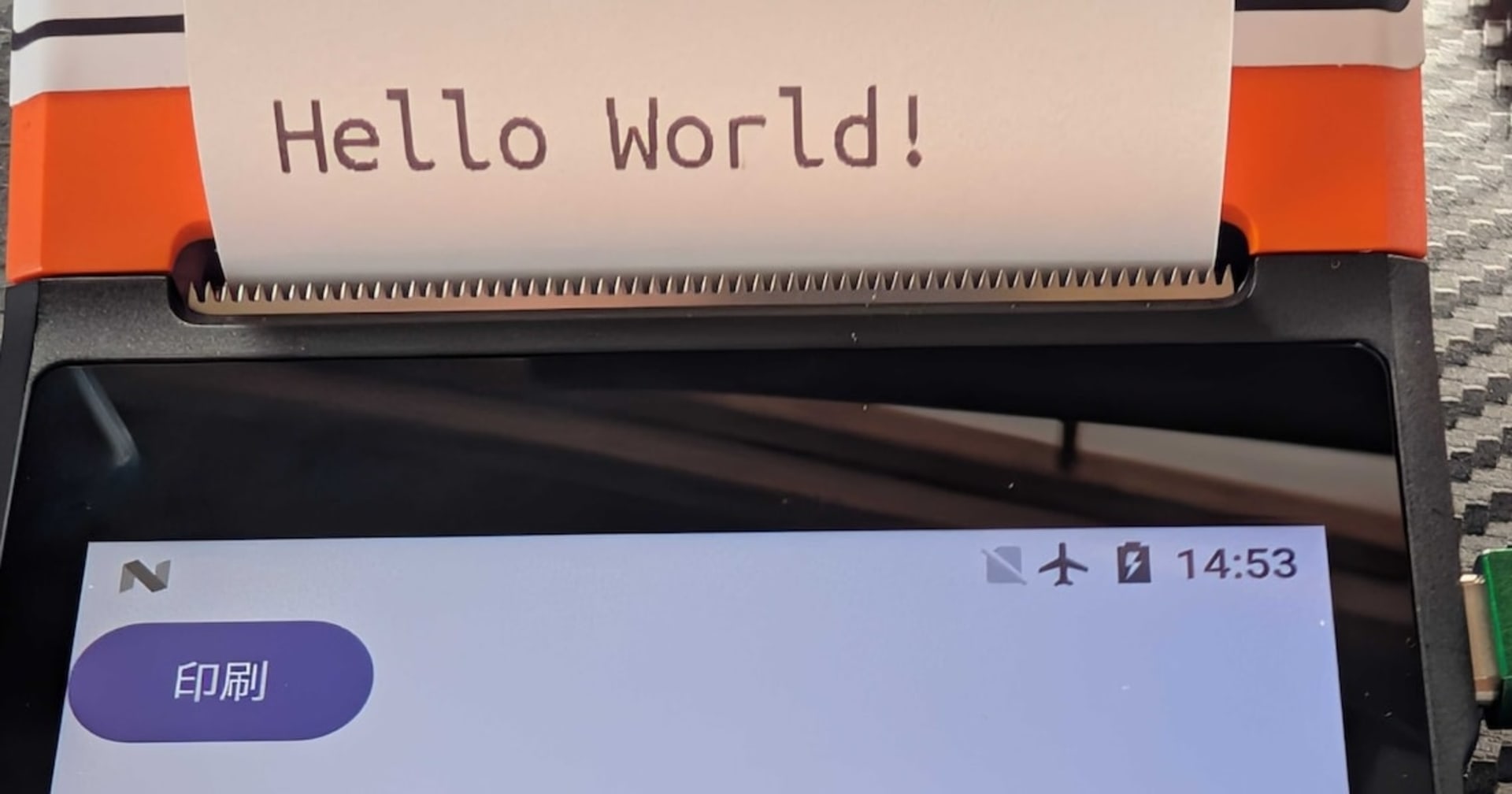
Androidコンポーネント初級編#3 : ExpandableListViewの使いかた
この記事は公開されてから1年以上経過しています。情報が古い可能性がありますので、ご注意ください。
今回はExpandableListViewの使いかたをご紹介したいと思います。 ExpandableListViewは、折りたたむことができるListViewです。 親子関係を持ったデータを扱うのでこれまでより少し複雑ですが、出来る限りわかりやすく解説したいと思います。 今回は下図のようなサンプルを作成します。
ExpandableListViewの作りかた
1.親のArrayListと子のArrayListを作る
まずはじめに、これまで同様リストに表示するデータを作ります。 前述の通り、ExpandableListViewは親子関係を持ったリストです。 そのため、今回は親のArrayList、子のArrayListをそれぞれ作ります。 親リストはHashMapのArrayList、子リストはHashMapのArrayListのArrayListを作ります。 少しわかりづらいですか、下図のようなイメージを持つとよいと思います。
親リストと子リストの関連付けはHashMapに含まれたキーと値のセットで判別します。 子は、親と同じキーと値を入れることで、その親の子になります。 要素1、2と書いてあるものは任意に入れることのできる値です。 子には表示する名前などが入ってくるかと思います。
2.SimpleExpandableListAdapterを作る
次に、ExpandableListView専用のAdapterである、SimpleExpandableListAdapterを作ります(長い名前ですね)。 このAdapterのコンストラクタ引数は第9引数まであります。少し多いですがそれぞれ入れていきます。 なお、SimpleExpandableListAdapterの引数に入れる値は以下のとおりです。
| 第一引数 | Context | Activityのコンテキストです。getApplicationContext()で取得できます。 |
| 第二引数 | List<? extends Map<String, ?>> | 親のリストです。 |
| 第三引数 | int | 親アイテムの表示に使うレイアウトのリソースIDです。 |
| 第四引数 | String[] | 親のレイアウトに表示するデータです。 |
| 第五引数 | int[] | 上記データをセットするTextViewのIDです。 |
| 第六引数 | List<? extends List<? extends Map<String, ?>>> | 子のリストです。 |
| 第七引数 | int | 子アイテムの表示に使うレイアウトのリソースIDです。 |
| 第八引数 | String[] | 子のレイアウトに表示するデータです。 |
| 第九引数 | int[] | 上記データをセットするTextViewのIDです。 |
3.ExpandableListViewにSimpleExpandableListAdapterをセットする
最後に、ExpandablListViewに2で作成したAdapterをセットします。 ここは前回までと特に変わっているところはありません。
ソース
SampleActivity.java
package cm.blog.sample;
import java.util.ArrayList;
import java.util.HashMap;
import android.app.Activity;
import android.os.Bundle;
import android.widget.ExpandableListView;
import android.widget.SimpleExpandableListAdapter;
public class SampleActivity extends Activity {
@Override
public void onCreate(Bundle savedInstanceState) {
super.onCreate(savedInstanceState);
setContentView(R.layout.main);
// 親リスト
ArrayList<HashMap<String, String>> groupData
= new ArrayList<HashMap<String,String>>();
// 子リスト
ArrayList<ArrayList<HashMap<String, String>>> childData
= new ArrayList<ArrayList<HashMap<String,String>>>();
// 親リストに要素を追加
HashMap<String, String> groupA = new HashMap<String, String>();
groupA.put("group", "さる");
HashMap<String, String> groupB = new HashMap<String, String>();
groupB.put("group", "とり");
groupData.add(groupA);
groupData.add(groupB);
// 子リストに要素を追加(1)
ArrayList<HashMap<String, String>> childListA = new ArrayList<HashMap<String,String>>();
HashMap<String, String> childAA = new HashMap<String, String>();
childAA.put("group", "さる");
childAA.put("name", "ニホンザル");
HashMap<String, String> childAB = new HashMap<String, String>();
childAB.put("group", "さる");
childAB.put("name", "テナガザル");
HashMap<String, String> childAC = new HashMap<String, String>();
childAC.put("group", "さる");
childAC.put("name", "メガネザル");
childListA.add(childAA);
childListA.add(childAB);
childListA.add(childAC);
childData.add(childListA);
// 子リストに要素を追加(2)
ArrayList<HashMap<String, String>> childListB = new ArrayList<HashMap<String,String>>();
HashMap<String, String> childBA = new HashMap<String, String>();
childBA.put("group", "とり");
childBA.put("name", "ニワトリ");
HashMap<String, String> childBB = new HashMap<String, String>();
childBB.put("group", "とり");
childBB.put("name", "スズメ");
childListB.add(childBA);
childListB.add(childBB);
childData.add(childListB);
// 親リスト、子リストを含んだAdapterを生成
SimpleExpandableListAdapter adapter = new SimpleExpandableListAdapter(
getApplicationContext(),
groupData,
android.R.layout.simple_expandable_list_item_1,
new String[] {"group"},
new int[] { android.R.id.text1 },
childData,
android.R.layout.simple_expandable_list_item_2,
new String[] {"name", "group"},
new int[] { android.R.id.text1, android.R.id.text2 });
// ExpandableListViewにAdapterをセット
ExpandableListView listView = (ExpandableListView) findViewById(R.id.listView1);
listView.setAdapter(adapter);
}
}
main.xml
<?xml version="1.0" encoding="utf-8"?> <LinearLayout xmlns:android="http://schemas.android.com/apk/res/android" android:orientation="vertical" android:layout_width="match_parent" android:layout_height="match_parent"> <ExpandableListView android:id="@+id/listView1" android:layout_width="match_parent" android:layout_height="match_parent"> </ExpandableListView> </LinearLayout>
実行結果
今回はExpandableListViewの使いかたのご紹介でした。 ArrayListの作成など少し難しいところはありますが、まずは試してみてください!












